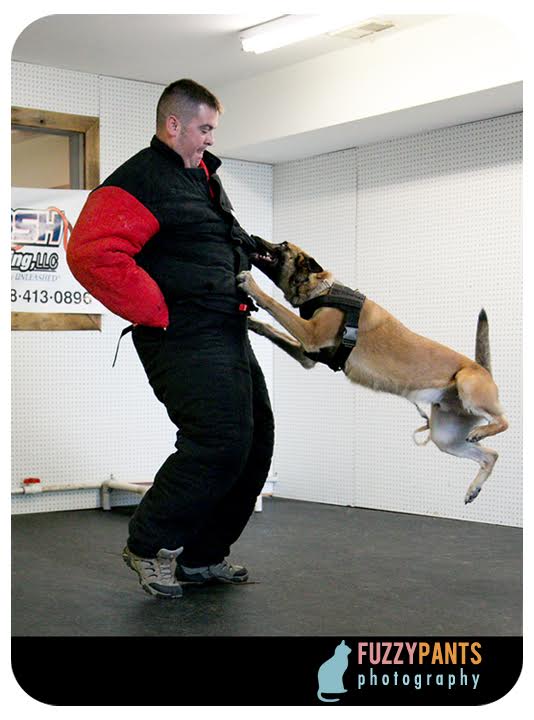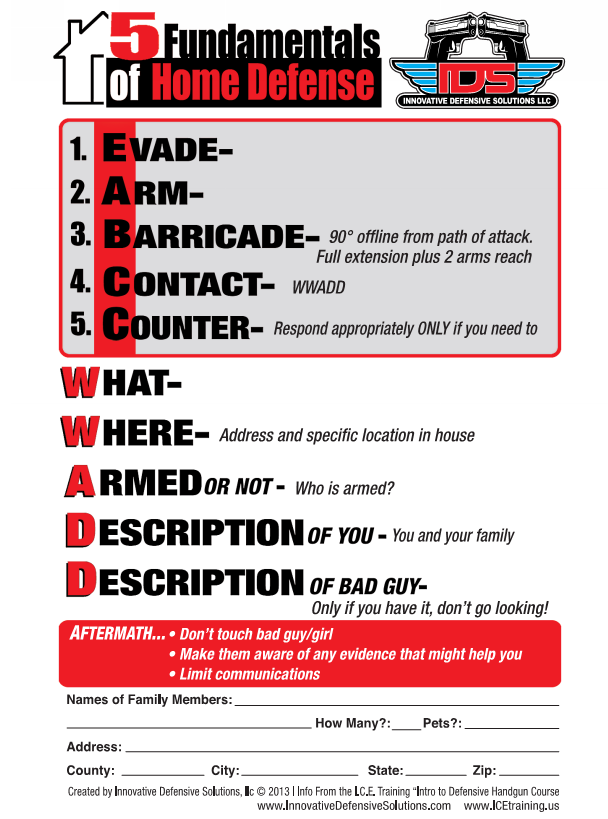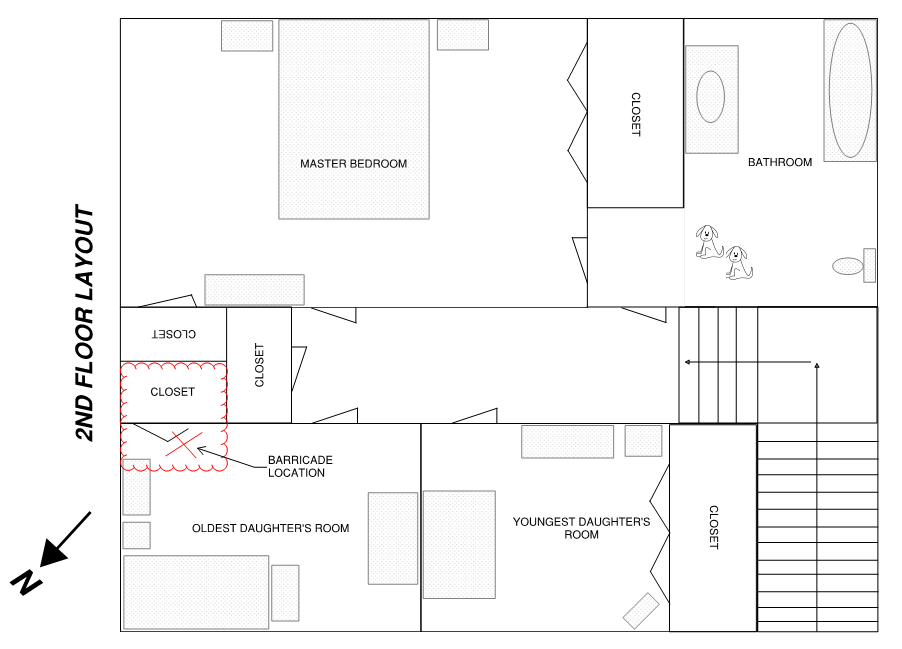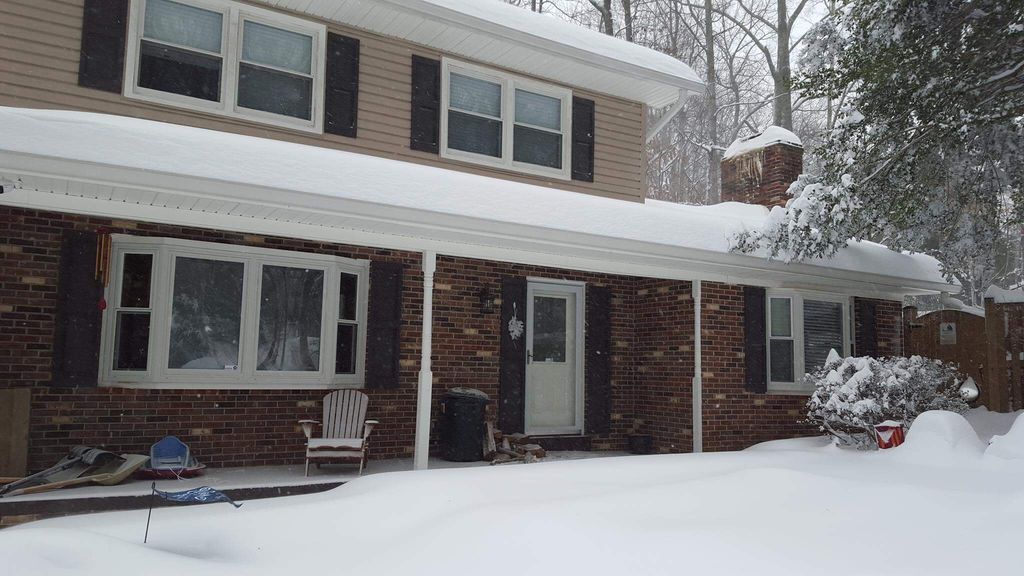
U.S. Department of Justice concluded that “On average, burglarized houses are less likely to have dogs than are non-burglarized houses, suggesting that dog ownership is a substantial deterrent.” Photo: author
Your pets should definitely be included in your home-defense plan. While your dogs may not be high-level personal-protection dogs, they can still serve as good deterrents for a would-be intruder. In my case, I have two dogs who are like my kids (who am I kidding, they are my kids) and I love them like my two non-furry daughters, so I have formulated a plan that includes them. Obviously, my main priorities are my two daughters and my wife, and they take precedence over the dogs, but the dogs are still part of our home-defense plan and help dictate some of the tactics I choose to think about and potentially use in an imminent home invasion.
COMPANION OR PROTECTION-TRAINED DOG?
First let me make a distinction. This article is for readers who have dogs that serve as companions, not for folks who train or plan on training a dog to bite for protection. While I think having a protection- or bite-trained dog is a great idea, that group is a much smaller and generally insignificant subset group of the larger group of dog owners in the U.S. It is estimated that over 60 million American households have at least one dog.
If you have a dog and make statements to your friends and family such as, “If someone breaks into our home, [insert dog’s name here] will attack them,” you should talk to some dog-training experts so you can re-evaluate those ideas. That thinking is akin to people who carry guns but don’t train and feel the gun is a talisman that wards off evil. But in reality it is just a tool — you are (or are not) the weapon. You won’t rise to the occasion, and neither will your dog.
While I understand that dogs are domesticated animals that can be unpredictable, and it is possible for a loving pet to bite unsolicited, there is a major difference between a dog that will bite and the few dogs that are trained properly and have the confidence to bite and stay latched on while a bad guy is striking the dog, trying to get them to detach. There is also a difference between a dog that bites out of fear and a protection/bite-trained dog. You may not have noticed this, but properly trained bite dogs enjoy what they do (i.e., biting). They wag their tails because they are working toward getting a reward, like a ball. It is a common misunderstanding that these dogs are mean, and even some dog people are scared of them because they think bite dogs are unstable. This couldn’t be further from the truth. Bite dogs are some of the most well-adjusted, albeit high energy and confident, dogs in existence.

Vast majority of dogs do not have the drive, confidence, and nerves required to be personal-protection dogs. Photo: Fuzzypants Photography
OFFICER SAFETY IN A HOME BURGLARY OR INVASION CALL
Another modality to understand is that of the officer(s) responding to your 911 call that someone is in your home. Let’s play a little visualization game and imagine you work for your local PD and are responding to an armed break-in call from a homeowner. You pull up in the driveway, enter through a front door that has been kicked in, and the only things you know are the homeowners are barricaded in an upstairs bedroom and an armed criminal is in the home. As you enter the doorway, a dog emerges from the kitchen area barking and growling.
Let me preface the next few sentences with the understanding that the dog may not be aggressive at all and the barking could represent several different things. But in that moment, whose life matters more? Yours or the dog’s? The dog may or may not be harmless. Let’s say you continue to go through your SOPs for room entry and clearing and disregard the dog, at which time the dog charges and starts to bite you. As you are fighting off the dog, the intruder enters the room, sees you (an LEO), raises his gun at you, and starts firing. Go back and think about that question again: “In that moment, whose life matters more? Yours or the dog’s?”
Many jurisdictions have policies and/or SOPs in place for situations like this, and they state to shoot the dog. I am not here to argue that policy, just to help you and your family – dogs and other pets included — lead a safer life. While many jurisdictions are actively seeking to learn more about this topic and revise their polices, as well as creating and/or revising the use-of-force continuums for dealing with dogs, it is important to understand the following: “If an officer is in reasonable fear of serious bodily injury or death, then deadly force is warranted, even if no other force options have been employed.”
In Brown vs. Battle Creek Police Department, December 2016, the United States Court of Appeals, 6th Circuit Court ruled and agreed with a lower court ruling, siding with the police officers. “The standard we set out today is that a police officer’s use of deadly force against a dog while executing a warrant to search a home for illegal drug activity is reasonable under the Fourth Amendment when, given the totality of the circumstances and viewed from the perspective of an objectively reasonable officer, the dog poses an imminent threat to the officer’s safety,” Judge Eric Clay wrote in the court’s opinion.
Furthermore, BCPD had the following relevant policy in effect at the time of the incident in question: “Vicious Dog, defined: An animal of the Canis familiaris species which, when either unmuzzled or unleashed, or when not confined to the premises of the owner, menaces a person in a manner which an ordinary and reasonable person would conclude to be an apparent attitude of attack.” (R. 61-3, Policy on Response to Resistance and Firearms, Page ID# 1−2.)
These polices and rulings are important information to understand and will help you place your dogs in your family’s home-defense plan. The intention of this article is to get you thinking about how to make your family, including pets, safer. Since I cannot cover all the possibilities, I describe one of the plausible responses to a home invasion in the scenario below. What are your plausible scenarios and responses?
FIVE FUNDAMENTALS OF HOME DEFENSE
Before we get to the scenario, let’s review the fundamentals of home-defense tactics that you have likely read about here on PDN and that we teach in our Fundamentals of Home-Defense Handguns course.
 With these fundamental home-defense tactics in mind, let me explain my scenario and plan regarding a home invasion that would occur at night while my family is at home and upstairs and/or in bed. I describe it in detail to encourage you to make your home-defense plans in equal detail, and then practice them.
With these fundamental home-defense tactics in mind, let me explain my scenario and plan regarding a home invasion that would occur at night while my family is at home and upstairs and/or in bed. I describe it in detail to encourage you to make your home-defense plans in equal detail, and then practice them.
HOME FLOORPLAN
We live in a three-story home on a private wooded 1.25-acre lot. Entry is made through the middle floor of the home. All three bedrooms are on the third floor and accessed by one stairwell in the front of the home. At the top of the stairs, two doors are on the left. Those are our daughters’ rooms — our youngest is first on the left, then our oldest. Across from our oldest daughter’s room is the master bedroom doorway, and working back toward the stairwell is a shared bathroom entry door. Entering that door to the bathroom, there is a door on the left that leads into the master bedroom. So the bathroom can be accessed from the hallway and/or through the master bedroom. (Yes, I know what you’re thinking… there is only one bathroom and I live with three females.
We keep the bathroom door in the master bedroom shut, so our oldest can use the bathroom at night and not disturb my wife and me, or the sleeping dogs.
In the case of a home invasion, our plan involves splitting up the responsibilities while keeping in mind the natural maternal instinct to run toward the kids. Of course we have in place many resistive layers the bad actor would have to get through and/or set off to gain access, including a security system with door/window contacts and horn, motion-activated lights both inside and out, a motion-activated chime when anyone gets within 25 feet of our door or garage, and the attentiveness and alertness of our dogs.
HOME-INVASION SCENARIO
At the point when one of those layers alerts us someone is trying to gain unauthorized access to our home or we hear the front door being kicked in, we would put the following plan into action. I would retrieve one of our defensive pistols from a quick-access safe on the nightstand and then usher the dogs into the bathroom, while making sure to lock the hallway door from the inside and shut the other bathroom door from the master bedroom.
My wife would go to the bedroom of our youngest daughter, closest to the stairs, to grab her from her crib. She would then enter the hallway, turn left and go into our oldest daughter’s room. She would wake her and get her in the corner of her room and barricade 90 degrees off line from the point of entry to the room. Based on the practice runs we have done, I would be exiting the master bedroom into the hallway and going straight across into the same room moments later. I would lock the door behind me and take a defensive stance in front of my family, again 90 degrees off line from the point of entry and at least two arms’ length from the door.
Depending on the status of the kids, either my wife or I (whoever is less task loaded at the time) would call 911. Ideally it would be my wife, since I would need to have most of my attention on the door and taking in the sounds coming from other parts of the house. But the reality is, with two children under the age of five, it may not be possible, since she would have to keep them quiet and barricaded in place behind me. We have both practiced the 911 call and prescribe to the WWADD mentioned earlier.

Understand your home’s layout, its deficiencies, and the best place to barricade.
(Click on image to enlarge.)
CALLING 911
For the purposes of this article, it wouldn’t matter if I were forced to defend my family by shooting the perp, or if they never came upstairs, as this article is about the safety of the dogs. Let’s move ahead to when law enforcement arrives on scene and enters the home to do a sweep for perps and to make an arrest. During the “contact” phase discussed above, WWADD was implemented. The fourth letter stands for “description of you.” That means the collective you, including all authorized persons in the home at the time, to possibly include guests, and to undoubtedly include dogs and their location in the home. The 911 call may sound something like this:
- 911: 911, what’s your emergency?
- Me/Wife: We have a break in/home invasion at 1234 Street Road, Manassas, Virginia. We are currently armed and barricaded in the northwesternmost bedroom on the top floor of the home, last door on the left in the upstairs hallway with the door locked. We have two friendly family dogs locked in the upstairs bathroom, which is the first door on the right as you get to the top of the stairs. (Describe what family members look like — size/age/clothing, etc.) I believe two perpetrators are in the home and I am not sure if they are armed or not. (If I have had to shoot, I would give a description of the perp.)
Locking the dogs in the bathroom gives responding officers a better chance of success when they enter the home because there is less noise and confusion. Not only does it ensure more safety for the officers by giving them the ability to focus on clearing the home efficiently, but it also hopefully keeps the dogs out of harm’s way from the criminals in the home and from law enforcement. It also makes things slightly less complicated for the family when trying to stay quiet and alert in the barricaded room. Especially considering the perp(s) may try to breech the barricaded location, the last thing you want to do is have a barking dog draw unwanted attention to your exact location, if it is unknown. The longer it takes for the invaders to find you, the more time law enforcement has to respond to your call.
Get educated, get quality training, formulate a plan, and practice it. Make sure you get the whole family involved in your dry runs so everyone knows how to respond, even the dogs. Stay safe, folks!

Glad you wrote this. I'd like to get a dog, mostly as an alarm of something unusual. Thanks for the info on protecting them as well.
How do I learn more of this? I live by myself.. cat and two dogs.
i've always worked at training my furry friends to be silent and not alert the intruder to their presence, just me, once the jerks come in it's "playtime" and they are free to have them for lunch. however they are also voice trained to disengage on command and depending on the status of the intruders either go to their crates or come to me so they present no threat to Leo's. presently i have 2 female pits ands a 22 tear old chiweenie whose a real noisermaker all by hinself.
We have dogs for that purpose, as the first line of defense. Having 2 large longhaired German Shepherds, an older Dane and a yappy 3lb Chihuahua as our wonderful alert systems,I’ve always wondered about the chaos that would take place during a home invasion. I never thought about the bathroom or a closet for their safety. Your article shined a light on our home situation. Many thanks.
Many good points in the article !! A few points to add. Keep old cell phones or get a few inactive cell phones, be sure they can hold a charge and keep them charged. Place these cell phones is your retreat - hiding areas to be able to call 911. Even though they are not active you can still call 911 on them. Things happen so fast you may not be able to grab you active phone to take with you into your retreat-hiding place.
Very good information and several things I never thought of, we have a small dog and a Great Pyr/ Anatolian Sheppard mix that normally stays with us in a threat and is very vocal.
Before my retirement and having to work some nights, I trained a German shepherd to not bark at an intruder, but alert us by growling in a low manner. After that if the intruder persisted the GSD attacked. He did not go for an arm or leg, but the body or his preference was the face or throat. He was raised with our children and my wife, and would have given his life with no cowardice despite the pain to himself. I lost him to cancer at the age of 11, and up to his illness he was a force of nature when he perceived a threat to his family.
Like most people who have companion dogs, I love them like children. However, my assumption is that someone that is serious enough to break into my house is probably going to neutralize the dogs. They will be making a racket. I will know that something is happening. Which by the way will put me in fear of my life. It is my personal hope that I never have to experience that fear or the consequences.
Size of the fight in the dog and all that. We have 5 Weenie Dawgs and while they certainly do not strike fear in anyone’s heart they do make A BUNCH of NOISE. That for me is piece of mind for day and night time at my house. When my badger dawgs get to raising cain at whatever is outside we can all tell if they barking at another animal like they are right now as I write or if it’s kids outside or if they are alerting us to something more dangerous as they have more than once.
I've owned dogs all my life. Love my dogs like family. My current friend is a large male German Shepherd. I have no doubt that he'd step up to the plate if an intruder came into the house. He's the best alarm possible. The sound of a pear or Apple falling off the tree out back is enough to get him from deep sleep to ready for trouble. That said, I don't want my dog doing anything more than alerting me and giving me the few extra seconds to prepare to respond myself. The last thing I want is my good friend getting injured or worse. You can't replace a loved one.